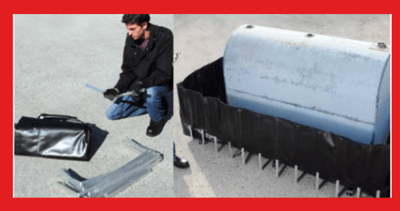Preventing Disaster: The Importance of Flexible Containment Solutions for Fuel Tanks

Imagine a scenario where a rigid spill containment system is the only option for a large fuel tank. While it may seem effective at first glance, the lack of flexibility in such a solution can lead to dire consequences. Let's delve into the potential pitfalls of not having a flexible containment solution and explore instances from the past that highlight the significance of adaptability.
The Rigid Conundrum: Rigid spill containment systems, though sturdy, come with limitations that become apparent in real-world situations. These limitations can escalate issues and pose threats to both the environment and operations.
1. Transport Troubles: Transporting a rigid containment unit for a large fuel tank can be a logistical nightmare. The sheer size and inflexibility of these units make them challenging to move efficiently. This becomes particularly problematic when tanks need to be relocated or transported for maintenance or other reasons.
2. Storage Struggles: Storing a rigid containment system is equally daunting. The cumbersome nature of these units demands ample space, making them impractical for facilities with limited storage capabilities. The lack of adaptability can result in unused or abandoned containment units, defeating the purpose of having a spill control system in the first place.
3. Emergency Response Delays: In the event of a spill or leak, swift action is crucial. Rigid containment systems hinder rapid response efforts due to the time and effort required to set them up. This delay can exacerbate the severity of spills, increasing the risk of environmental damage and potential legal repercussions.
Learning from History: History has witnessed instances where inflexible containment systems contributed to environmental disasters:
1. Exxon Valdez Oil Spill (1989): The lack of a flexible containment solution played a role in one of the most infamous oil spills in history. The Exxon Valdez tanker's rigid containment system failed to effectively control the spill, resulting in devastating consequences for Alaska's ecosystem.
2. Deepwater Horizon Oil Spill (2010): The inability to swiftly deploy effective containment measures compounded the impact of this disaster. The rigid systems available struggled to adapt to the dynamic conditions of the underwater well blowout.
Introducing Flexibility for a Safer Future: Flexible containment solutions offer a way to overcome the limitations of rigid systems. The Ultra-Containment Sump Flexible Model, for instance, bridges the gap between effective spill control and adaptability. By providing a durable yet mobile solution, it addresses the challenges associated with transport, storage, and emergency response.
Maximizing Spill Control: Exploring the Versatility of the Ultra-Containment Sump Flexible Model
When it comes to containing spills from fuel tanks, size matters. Introducing the Ultra-Containment Sump Flexible Model – a dynamic solution that marries durability with portability for seamless spill control.
Understanding the Need for Flexibility: Fuel tanks, whether stationary or mobile, require spill containment measures to ensure environmental safety. However, the challenge arises when dealing with large tanks that require equally sizable containment systems. This is where the Ultra-Containment Sump Flexible Model steps in, addressing the inconvenience of transporting or storing these containment units.
Innovative Design for Practicality: The Flexible Model Containment Sumps are constructed from a highly durable material that is supported by L-brackets. This combination effectively contains leaks, drips, and spills, safeguarding the environment and mitigating potential hazards.
On-Demand Mobility: What sets this model apart is its adaptability. When the need arises to move or store the sump, the L-brackets can be easily removed, and the material can be folded up. This flexibility streamlines transport and storage, making it an excellent solution for those who require spill containment on the go.
Key Features:
- Economical and Portable: The Flexible Model offers cost-effective spill containment for 1000-gallon tanks, perfect for scenarios where mobility and budget considerations come into play.
- Sturdy Support: L-shaped aluminum brackets provide robust sidewall support, ensuring the sump maintains its structural integrity while containing spills effectively.
- Convenient Sizing: Standard sizes are designed to fit most fuel tanks, simplifying the selection process. Furthermore, the brackets' easy removal and material folding allow for compact storage and hassle-free transport.
- Efficient Shipping: Folded units and L-brackets are shipped in boxes that are suitable for UPS shipping. Note that larger models might require truck shipping (common carrier) due to their size.
Swift Installation for Swift Action: L-Brackets enhance user-friendliness by being quickly and easily installed in heat-welded sleeves around the perimeter of the sump. This seamless integration ensures the sump is ready for action when needed.
In essence, the Ultra-Containment Sump Flexible Model redefines spill containment by combining durability and mobility. Whether you're in the transportation sector, working with mobile fuel tanks, or require versatile spill control, this model offers a practical solution that prioritizes both environmental protection and user convenience.
Visit the Flexible Spill Containment Sump page here


